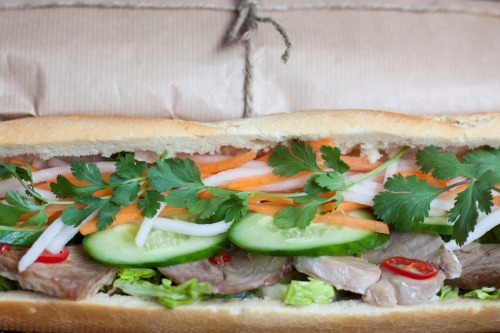Banh mi, Sydney style
 Monday, May 9, 2016 at 8:51PM
Monday, May 9, 2016 at 8:51PM 
I was so excited when I first saw bahn mi in London. They were one of my favourite lunches when I was a growing up in Sydney. There was a Vietnamese bakery next to my school where most kids used to load up on doughnuts and cream cakes. I preferred to spend my pocket money on 'Vietnamese pork rolls'.
For $2.50 you could get a Vietnamese baguette slathered with pate and mayo, crammed full of cold pork cuts, salad and pickles and finished with soy sauce, a few sprigs of coriander and a sprinkling of chilli.
I have found few places in London that make them like this, perhaps because the French and Asian flavours sound like such a bizarre combination. Actually, I think that’s what makes it unique and interesting. It speaks to Vietnam’s colonial heritage and is a great example of fusion cuisine that really works.
The French introduced the baguette to Vietnam and probably the idea of filling it as well. Vietnamese baguettes are made with rice flour, as well as wheat flour, and the result is lighter and crispier. If you can’t get your hands on one of these though (I couldn’t), a small French-style baguette will do just fine.
Over time and as the idea has travelled, bahn mi has started to incorporate many more exotic meats and flavours. In Sydney, the choice was pork or chicken. In London, most bahn mi joints offer anywhere from 6 to 10 options covering bases such as BBQ pork belly, meatballs and sugarcane prawns.
For my latest Borough Market series, Box Clever, I tried to recreate the bahn mi that I grew up with. The only exception is that I used leftover roast pork, in place of Vietnamese cold cuts, since I was trying to make use of ingredients that would readers might have to hand. On that note, you can swap the daikon for another variety of radish, if that’s easier. Or ditch it entirely.
Makes 2 baguettes.

Ingredients
1 tbsp rice wine vinegar
3 tsp caster sugar
75g carrot
75g daikon
2 tbsp light soy sauce
1 tsp fresh ginger, peeled and grated
1 mild red chilli, sliced into thin rounds
250g leftover roast pork, sliced or shredded
2 small baguettes
2 tbsp mayonnaise, or to taste
75g country-style pork pate
1 baby gem lettuce, sliced into strands
1 cucumber, sliced
Few sprigs coriander
Method
In a small mixing bowl, whisk together the rice wine vinegar, 1 tsp of caster sugar and a pinch or two of salt, to taste. Peel and julienne or grate the carrot and daikon and add to the bowl. Toss to coat, cover and put to one side.
In another bowl, whisk together the soy sauce, grated ginger and 2 tsp of caster sugar until the sugar dissolves. Add a pinch or two of the sliced chilli, to taste. Add the pork and toss to coat.
Slice the baguettes down one side, open and spread each on one side with 1 tbsp of mayonnaise and half of the pate. Add the lettuce, pork, pickled carrots and daikon, cucumber slices and finish with a few sprigs of coriander.
If you like your sandwich extra salty and juicy, make some more of the soy sauce dressing and add it just before eating.


Reader Comments (3)
Nice post, living in Hanoi, I'd suggest you add some very soft or even deliberately melted butter too, plus give the Gio sausage a go at some point, it's often used in sandwiches in the north. http://foodsvietnamese.com/vietnamese-sausage-gio-lua-recipes/
It's Banh Mi by the way :D
Hi JD, thanks for tips. I have renamed the post - oops! Will defo try the sausage if I can procure it in London :-)
For a change, there is an article that focuses on a specific topic and is not all over the places. I like the fact that it is actually problem-solving and not just random and baseless subject. Great going!